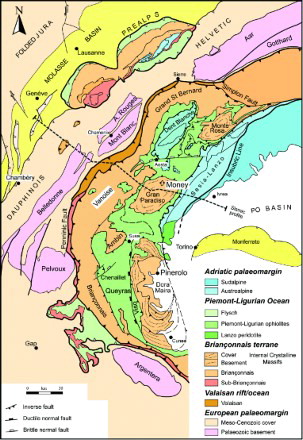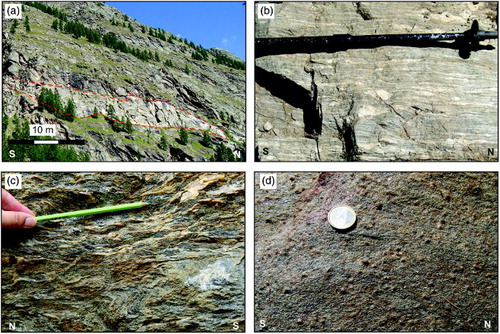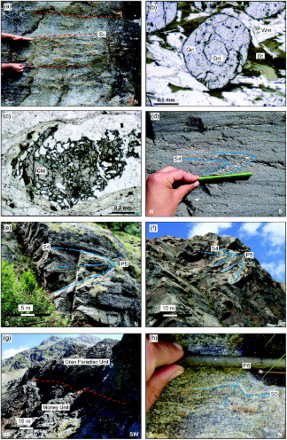Figures & data
Figure 1. The Gran Paradiso nappe in the Western Alps (in evidence the Money unit): simplified structural and geological map (modified after Le Bayon and Ballèvre, Citation2006).

Figure 2. Main rock types and structures in the Money Unit. Letters in white at the bottom of each picture indicate the cardinal points. (a) Erfaulet metagranite: preserved igneous texture with subhedral Kfs crystals; (b) Bt-Amp orthogneiss: L4 lineation is marked by Amp; (c) Ab-paragneiss with a banded structure defined by Wm-Chl layers alternating to Qz-Ab-rich bands. A deformed dark green layer of amphibolite is enclosed in Ab-paragneiss; (d) Quartz meta-conglomerates (MMF), folded by D5 folds and strongly stretched parallel to L4 lineation; (e) Quartz-micaschist (MMF) with mm-size garnet crystals; (f) Stratigraphic contact between meta-conglomeratic layers (PMF) and a cm-thick band of graphite micaschist. The meta-conglomeratic layer contains pebbles and lenses of quartz and fine-grained leucocratic aplitic gneisses.

Figure 3. Main rock types in the Gran Paradiso Unit. Letters in white at the bottom of each picture indicate the cardinal points. (a) Valmiana orthogneiss occurs as a ten-metre-long scale layer; (b) Mylonitic orthogneiss showing centimetre-sized porphyroclasts of potassic feldspar. The pervasive foliation (S4) is marked by Qz-Fd lithons and by Bt films; (c) Grt-Cld micaschist showing a well-developed foliation (S4); (d) Grt-paragneiss characterised by mm-scale garnet crystals.

Table 1. Deformation, metamorphic and magmatic history of the Money Unit, according to Compagnoni et al. (Citation1974) and Le Bayon and Ballèvre (Citation2006).
Table 2. Relative chronology of meso-structures and their mineral support and schematic relationships between deformation, magmatism, metamorphism and sedimentary history in the Money Unit.
Figure 4. Main structures in the Money and Gran Paradiso Units. Letters in white at the bottom of each picture indicate the cardinal points. (a) 20 cm-thick layers alternate to Qz-micaschist bands (MMF); (b) Petrological evidence of contact metamorphism (Le Bayon and Ballèvre, Citation2004): Pre-Alpine garnet core in a Qz-micaschist (MMF) close to the contact with the Erfaulet orthogneiss (plane-polarised light); (c) Qz-micaschist (MMF): Garnet porphyroblast with chloritoid and quartz inclusions (stage 3) (plane-polarised light). (d) Meta-conglomeratic layer (PMF): centimetre-scale D5 fold; (e) Ab-paragneiss: metre-scale isoclinal D5 fold; (f) Gr-micaschist associated with meta-conglomeratic layers (PMF): S4 foliation is folded by D5 folds; (g) Contact between the Money and the Gran Paradiso Units continuously outcroppoing over hundred metres distance; (h) Qz-micaschist associated to meta-conglomeratic layers (MMF): centimetre-scale D6 folds.

